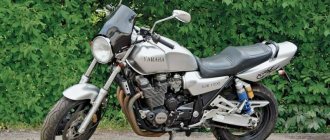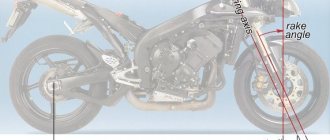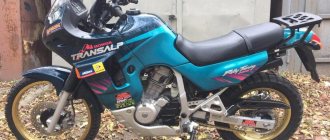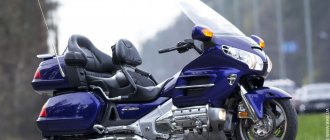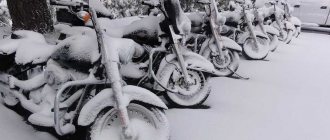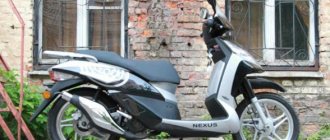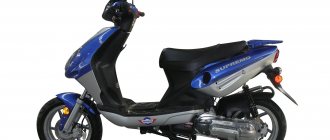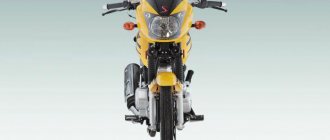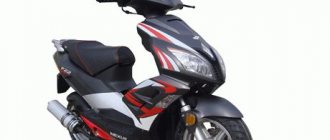Today, motor-wheels for electric bicycles are very popular among users, so every self-respecting user wants to know as much as possible about this device. In this topic I want to talk about spoketing a motorized wheel and give an example of doing it yourself. This information will be useful to any cyclist who decides to engage in MC spokes with his own hands - this will allow him to turn his plans into reality as correctly as possible.
Why are knitting needles needed?
The quality of the wheels of any bicycle is directly dependent on the level at which their components are made. A traditional bicycle wheel consists of a rim, spokes and a hub. The spokes are responsible for connecting the hub to the rim; they provide the wheel with not weak strength at a modest weight. In addition, the spokes are a kind of shock absorbers; their flexibility allows you to distribute the load over the entire rim. These elements center the rim, hold the shape of the wheel and give it rigidity.
The design of the spoke is not complicated: one end is riveted and bent, and on the other there is a thread for a mushroom-shaped nut (nipple) that attaches the spoke to the rim. The thread can be threaded or rolled. The latter is considered more reliable.
Selection of knitting needles for MK
Motorized wheels for electric bikes designed for 36 spokes are the most common, but there are also 32- and 28-spoke modifications. There are also more exotic, 16- and 14-spoke variations. However, attention should be paid not only to the knitting needles. So, it is better to install a double rim, because the electric motor increases the load on the wheel.
Here’s another nuance: rims that are identical in outer diameter may differ in inner size, so not all spokes will be the right length. In this regard, first of all we pay attention to their length, and then to their thickness.
The motor flange diameter is often much larger than the flange diameter of a traditional hub. And from this the conclusion follows: standard knitting needles cannot be fitted one hundred percent; shorter ones are needed.
Motorized wheel spoke patterns
Radial (“sun”)
This method is used for front brake discs, on which rim-type brake mechanisms can be installed. The radial system has one significant drawback - a serious vertical load on the spokes. But the advantages of this technique include beauty!
"Crosses"
The scheme is practical and versatile. Of course, from the outside, such intricacies do not look very attractive, such as a radial installation, but with a cross pattern, even serious loads generated by braking and pedaling are neutralized by the stretching of the spokes.
Combined scheme
It combines the features of the two schemes above, but this knitting technique is used much less frequently.
❗Nuances
The spokes enter the rim at an angle (except for the radial pattern) and this is what allows them to form a cross. This approach increases strength and evenly distributes the load. The more crosses, the more evenly the force is distributed, and the smoother its distribution, the less chance of an “egg” or “figure eight” forming after a hard collision of a wheel with an obstacle. But at the same time, if there are too many crosses, then the risk of deformation of the spokes increases.
In general, MK spokes can be 1 cross, 2, 3, or even 4. The latter pattern is suitable for large diameter wheels equipped with a small hub.
However, if you take a large bushing as an example, then most likely you will be able to knit the MK into one cross, well, at most, into two. If you try to introduce too long spokes into the design, be aware that they will fit into the nipple with a bend. In this state of affairs, unfortunately, you will not achieve an improvement in load distribution, but an unpleasant decrease in strength awaits you.
The optimal spoke pattern is selected taking into account the diameter of the rim and the hub motor:
✅ Small rims, combined with a relatively large electric motor, are knitted using the radial method. Other schemes with such a combination are simply not applicable.
✅ Rims with a medium diameter, knitting according to a single-cross pattern.
✅ Rims of solid diameter combined with small geared electric motors are knitted into a pair of crosses.
Some users who order a spoked hub motor with an outer diameter of 240 millimeters into a 20-inch rim express their negative attitude towards its radial spokes. In their opinion, the only correct pattern in this case may be a double-cross knitting pattern.
In connection with this misunderstanding, experts have the following question: how can a user even imagine such a variation of the spokes when a gap of 100-150 mm on each side is formed between the engine and the rim. Electric motors of impressive diameter can only be connected to a small rim using a radial design.
Are you suspiciously contemplating your sixteen-inch wheel, into which it is planned to accommodate a 13-centimeter electric motor, fixing it with standard spokes? You are doing the right thing by doubting! An increase in load requires replacing the spokes with reinforced ones and the rims in addition.
Stock spokes can actually work as part of a motorized wheel, but, unfortunately, not for a long time. Radial and single-cross spokes will suffer the most when the wheel is heavily loaded overall.
How many spokes are there in an enduro motorcycle wheel?
If the decision has already been made, your hands are itching and you don’t want to ride for at least a few days, then you can move on to work. Next, I will only talk about the front wheel.
I'll warn you in advance. I did this in December 2008, so I could be wrong in the numbers.
1. Buy knitting needles. The simplest option is the original through existential, megazip and similar hucksters. Most likely the knitting needles will not have to be modified, but it will be very expensive! At one time I took a different path. On Stead, the front wheel has 56 spokes, the rear, I think, has 52 spokes. Experts will correct me. It turns out that out of 50+ spokes of one wheel, half are conditionally short, half are long. The cross-sectional diameter of the knitting needle is slightly less than 4 mm. One of its ends, which fits into the holes in the hub, is bent at an angle of approximately 70 degrees and has the shape of a mushroom cap. The other end has a thread and a special nut. Only Ural knitting needles were found on the market for such parameters! By the way, at that time 1 knitting needle cost 10 or 15 rubles. But there are several nuances:
a) the Ural knitting needles are all the same in length (at least I didn’t find any different ones) and longer than the Steedov ones: longer than the short Steedov ones by about 25-27 mm and longer than the long Steedov ones by about 7-10 mm. Accordingly, when trimming, the thread will need to be cut or re-cut (depending on what and how you cut it)
b) at the end, which is attached to the hub, the Ural spokes are bent at a right angle instead of the 60-70 degrees we need, i.e. they will be needed. unbend.
c) finding 100+ perfectly beautiful shiny Ural knitting needles is not easy, especially since when purchasing, it will probably not be clear whether the knitting needle is good or bad, because In a good way, they are sold covered with brown factory grease.
d) the Ural spoke is 4 mm in diameter, and its nut is much wider than the nut of the Steed spoke, i.e. You will need to drill out the original rim.
e) there are original Ural spokes (factory), and there is something left-handed, probably from China. So, it’s better to take it and work with your family. Despite the fact that the Chinese knitting needle is more beautiful and shiny, it is impossible to bend it even a little, and this is important for us, and it is very difficult to cut a thread. Chinese knitting needles can be distinguished by two characteristics: they are completely shiny and, as a rule, they have a bent and wrinkled “mushroom” cap. Russian knitting needles have a normal somewhat matte steel color - they are not chrome-plated!
f) you should buy only spokes with fastening nuts screwed on them. Steed's old ones won't fit there.
2. We disassemble Steed's wheel. We disassemble the tire, take out the tube, and remove the rubber band. The tape can be covered with rust just like the knitting needles. That’s what happened to me, I threw it away, then cut a new one from an old car camera. I recommend that you first remove just one long and one short knitting needle. Yes, in order to completely remove one spoke at a time, you will need to unscrew several adjacent spokes (about 10 pieces).
3. Let’s put a Ural spoke and different Stead spokes next to each other and we’ll immediately see how different they are. And then simple mechanical work - straightening, threading, shortening. It is important to do the shortening after cutting the thread, because using a finished thread, continuing to cut a new one is much easier than when the thread is cut and we have a “bare” knitting needle in front of us.
4. Extension of the Ural spokes. We wrap the “fungus” with a cloth so as not to damage it, clamp it in a vice and bend the knitting needle with our hands to the required angle (60-70 degrees). I didn’t even straighten it in a vice, but at home in front of the TV, using a more powerful clamp. First you will have to measure the angle, but believe me, after the 20th needle, things will go faster. If you bend it to a slightly larger angle, it’s not so scary. Everything will be fine when reassembled. I’ll say it again, Chinese knitting needles bend very badly and in the wrong place
5. Thread cutting. I repeat once again, it is better to do this before shortening the knitting needles. I don’t think there’s any need to describe how to cut a thread. Again, you can find this on the Internet. You need an M4 die, a convenient die holder and machine oil. And again, Chinese knitting needles are very difficult to cut threads, the die gets very hot, becomes dull, and even oil does not help.
6. Now we can shorten our knitting needles (cut off the excess thread with a grinder). This operation is the fastest. 50+ pieces can be shortened in half an hour.
7. If everything was successful and there is no fear of the unknown left, then we continue to disassemble our wheel, at the same time using a drill to drill out each vacant hole for the Ural spoke (more precisely, the nut, the Steed nut is smaller in diameter than the Ural one), inserting new spokes.
8. After replacement we have a beautiful shiny wheel, but that’s not all. The dancing continues. We put a rubber band on the rim, covering the spoke nuts, put on the tube, and the tire. We inflate the wheel to normal pressure and place it on the motorcycle. Now let’s spin the hanging front wheel with our hands. Then the time comes to be surprised at how crooked it has become. We panic a little, calm down and continue working
9. To remove all vertical and horizontal (figure eight) beats, you need to arm yourself with a spanner for tightening the knitting needles, a piece of chalk and patience. The technology is simple and old, it was used in childhood when repairing wheels after driving along stairs and curbs. To remove the figure eight (horizontal runout), hold the chalk with your hand so that when the wheel rotates, a white line is drawn on the side of the rubber. Due to the presence of the eight, the line will appear and disappear. Where the line is thickest, there you should tighten the knitting needles in the direction opposite to the chalk. The same procedure is used when detecting vertical runout, only we hold the chalk on top. And so on for several hours with checks and re-checks until the required results are achieved.
10. Well, that's all. We take off the wheel, go balance it, put it back, ride around and show off our shiny new spokes
Calculation of knitting needles for MK
Below is a list that displays the values of calibers accepted in the States (Gauge, G), translated into mm familiar to the Russian-speaking user:
We discard the 16th and 17th gauges right away - they are used in racing modifications, for which low wheel weight is of great importance. And 4th and 8th gauges are used on the wheels of motorcycles and cars.
The list does not include outlandish variations: knitting needles of variable thickness, oval, flat, and teardrop-shaped cross-sections. Such parts are specially adapted for racing bicycles, where weight and aerodynamic characteristics are a higher priority than long service life. In addition, not all knitting needle manufacturers focus on the overseas system, and therefore you may come across good quality knitting needles with a cross-section of, for example, 3.05 millimeters.
The wheels of the average bike are most often equipped with spokes with a cross-section of 1.8 and 2.0 millimeters, but 2.3 mm are also found. Such indicators will be quite sufficient for long-term operation under standard conditions. When electrifying a bicycle, you need to take into account that its total weight will increase, so you will have to deal with the spokes in any case.
Rules for choosing spoke caliber
A motorized wheel must have stronger spokes than a standard bicycle wheel. For example, if before the introduction of the electric motor, 2 mm products were used on your bike using a double-cross pattern, then to knit the motor into one cross, you will need spokes with a cross section of at least 2.6 mm or even thicker. In addition, the choice also depends on the power potential of the electric motor used.
The table below shows the approximate spoke sizes for mounting MKs with different power ratings in rims of different sizes:
2T Motorcycles, Mopeds, Scooters
Restoration of Nickel-silicon coating (Nikasil). The cost does not include welding work to restore the cylinder, if required.
5% discount on piston and gasket set!
Restoration of Nickel-silicon coating (Nikasil). The cost does not include welding work to restore the cylinder, if required.
5% discount on piston and gasket set!
Restoration of Nickel-silicon coating (Nikasil). The cost does not include welding work to restore the cylinder, if required.
5% discount on piston and gasket set!
Restoration of Nickel-silicon coating (Nikasil). The cost does not include welding work to restore the cylinder, if required.
5% discount on piston and gasket set!
Restoration of Nickel-silicon coating (Nikasil). The cost does not include welding work to restore the cylinder, if required.
How to knit a knitting needle with your own hands
Ideally, MK knitting should be entrusted to professionals who will carry out this tricky operation using special equipment. At the end of the event, the assembled electrified wheel is adjusted and tested at the stand. This eliminates out-of-roundness and lateral runout.
But, if you have a strong desire to knit the MK with your own hands, no problem. Only you must have the proper amount of patience and time for this. This process must be treated extremely responsibly, because if you do not follow the correct algorithm, various types of malfunctions can make themselves felt, ranging from rubbing of the spokes when they come into contact with each other, ending with falls that are dangerous for the rider.
Getting ready for the process
Before you start knitting the MK, you need to understand where exactly the knitting needles will be inserted and determine the order of their installation - this is extremely important. Figure out which parts you will fit in parallel and which in a cross pattern. Also, it is necessary to calculate through how many holes each subsequent knitting needle will be inserted.
To make the knitting process easier, you can turn the bike over and use the front fork.
Also, before starting, find out what length of knitting needles should be used. If the electrified wheel is placed on the front axle, then it will be easier to deal with it - the length is identical. But on the rear wheel there are speeds, so alignment is accompanied by difficulties. Its knitting needles differ in length, and their angle of inclination also varies. By the way, to calculate the appropriate length of the knitting needles, there is a special calculator .
Here's what else you need to know: Most hub powertrains are designed with 36 spokes, so a 32-spoke rim won't work for them.
The main principle of knitting: from the right flange - into holes inclined to the right, from the left - into holes inclined to the left.
There are two types of spokes on the flanges - they are equal:
- Tails. They are directed in the direction opposite to the rotation of the rim and are often indicated in red tones.
- Leading. They are directed in the direction of rotation and are usually indicated in blue tones.
Installing the spokes
For the technical maneuver we will need: spokes of a suitable length, an electric motor of the appropriate type, a rim, a bushing, a spoke key and also a screwdriver.
So, we insert a tail-type spoke from the outside of the right-hand flange and fit it into a hole on the rim inclined to the right, located behind the spool. In order to prevent the spoke from falling out, we attach the nipple. We also bridge the next knitting needle into the hole of the right-hand flange, at a distance of three holes after the first.
Then we turn the MK with the left flange towards us. We scroll the rim up with the spool and then introduce tail-type spokes. If the starting spoke is inserted into the first hole behind the spool, then we adapt the first spoke of the left-hand flange to the left. If it is in the second hole behind the spool, then we bridge the first spoke of the left-hand flange to the left of it.
We finish installing the tail elements and move on to the leading ones. We install the motor-wheel with the right-hand flange facing us and fit the spokes into arbitrary holes on its inner side. Having inserted the spoke, turn the bushing clockwise. This action will allow us to achieve the intersection of the leading element with the three tail ones: two spokes will lie on the outside, and the third on the inside. If this becomes necessary, the knitting needles can be slightly bent. We fully implement all the spokes.
Adjusting the tension
This ritual must be performed in order to give the rim maximum roundness, that is, no “egg-likeness”.
So let's get started:
1. We press the MK axis with nuts. Next, we pull the spokes with identical force, turning the nipples alternately by an equal number of turns, but do not tighten them to the limit.
2. Now we need to eliminate the “ovality” - radial runout, which is formed due to unevenly tensioned spokes. Next we need an indicator or an ordinary chalk. We adapt it near the fixed part and provide a gap of 1-2 mm to the end of the rim edge. We begin to rotate the MK. In those places where chalk marks appeared, you will need to slightly tighten the nipples. Here, by the way, you should be careful: on nipples made of various alloys and brass, it is very easy to screw up the threads, but steel products are more reliable in this regard.
3. Getting rid of lateral runout. We press the chalk to a stationary area on the side of the rim and begin to rotate the electrified wheel. We tighten the knitting needles located in the flange on the opposite side of the points marked with chalk. As for the tolerances used in production, discrepancies in runout and ovality should not exceed 1.5 mm. This figure can be reduced to 0.5-1 mm, but this will require special bench equipment.
The spokes are stretched to such an extent that they “ring”, as this affects the reliability of the e-bike, and safety should not be forgotten. You should not think that you will make the adjustment once and then you can safely forget about this event for the rest of the time. In reality, you need to tighten your spokes at least once a month. If you use your electric bike for riding on rough road surfaces, you will need to adjust the spokes even more often. If you have serious impacts with the rim on an obstacle, then the check should be carried out immediately after the incident.
And finally, I suggest watching a video in which you can get acquainted with the personal experience of one user’s motor-wheel spokes:
Conclusion
As you can see, with an electrified bicycle, the issue of spokes is not so simple. Obviously, the increased load will require reinforcement, so the spokes will have to be dealt with in any case, in addition, the rim must also be reinforced. The information provided in the article should ease your pain, if you plan to do everything yourself.
However, if you simply don’t have the appropriate skills, patience or time, then there is no point in torturing yourself - contact good professionals and they will organize everything properly. The only thing that remains for you is to enjoy high-speed rides on an e-bike, without worrying that something will fall off your bike during the hectic rides.
Motorcycle rims. Cast or wired? Which is better and why.
We compare the types of motorcycle rims. Cast alloy, crossed steel spokes, carbon, hubless. Which technology is better for which classes of motorcycles and applications. What wheels to put on your motorcycle.
- 12097
- 41
Cast wheels are repaired only on the road, and the broken parts are welded on and the geometry is restored. It is much cheaper to remove the same dent on the side of the casting than to change the rim of a spoked wheel)
Fedotov, Dim, I'll give you that white disc from the jixer. Will you restore it? 
HM_Channel, it’s cheaper to buy a wheel from a jixer on Avito or Ebay, but yes, if you really want to, you can restore it, but the price of this procedure will be close to the price of a new wheel, or even surpass it. And yes, a wheel embedded in a wall and a dent on the side are not the same thing. Knitting needles, as I understand it, don’t roll very well?
Fedotov, well, did you see the broken disc from the goose in the video? We re-spoke it to a new rim. The asking price is half the cost of a new alloy wheel.
HM_Channel, How much is this in rubles?
HM_Channel, I wasn’t too lazy to find the picture. The rim was bent so that a crack appeared. They did it for 4 thousand, I just don’t remember, with or without painting.
Of course, not a single motorcycle manufacturer allows any repairs, especially this kind, but we live in Russia. And yes, everything is balanced normally, the motorcycle has been running for several years.
Fedotov, this is some kind of show-off, did you even watch the video?
I believe this is the disc from the jixer 
Jackson, yes, I saw the video and CD from Jixer. It is this particular wheel, apparently imprinted into something hard at high speed, that is cheaper to buy at a disassembly than to repair. A spoked wheel with such a crash would look about the same, only there would be more spokes torn off.
At the same time, if you forget about economic feasibility, you can revive this wheel, even by welding the rim from the donor disk. Well, let’s imagine that you live in 2117 and are restoring pre-revolutionary old-regime jixers for which, in principle, there are no spare parts. I repeat, the manufacturer is not your friend here, just change it at the factory.
As for less severe breakdowns, for example, the disk was bent in only one place, or a piece broke off, then all this can be treated and treated for pennies in comparison with buying a rim for a spoked disk.
Those. If you don’t have a Turkish casting, but a disc that’s worth anything, it’s cheaper to repair even such hell than to buy a new one. Rims, as you understand, are not treated that way. The rim, especially if it went as a figure eight, can only be changed.
Fedotov, if the figure eight is small, then you can stretch it out with knitting needles.
What do you mean by “penny”? In 2021 I bought a 21″ DID DirtStar LT-X rim for only $110. Re-knitting cost something like 3,500 rubles, plus a set of knitting needles another 3,500, because the old ones were so acidified that it was faster and easier to cut them with a grinder. Of course, I could have saved money by soaking them, but the insurance company paid me normally for the accident, so I just bought new ones.
Cyrix, 3500 + 3500 + 6000 is how much? Wouldn't it be cheaper to buy a slightly worn wheel with an original rim? Z.Y. Somewhere above, Boris voiced the cost of a rim per goose, so you can roughly feel it.
Fedotov, no, not cheaper. On my model, the wheels don’t lie on every corner; they don’t fit on cross bikes without modification. A set of used wheels for my motorcycle from 30k starts at the secondary market. New from 40k per set.
Cyrix, well, you millionaires have your own quirks)
Fedotov, Dim, you are comparing the incomparable. Of course, a new rim from a goose costs more than a collective farm repair of a broken casting from some shaggy seabird. It's stupid to argue with this. But the owner of the goose will not give himself a boiled disc from the seabill. Unless he's out of his mind, of course)
HM_Channel, the whole point is that the collective farm repair of broken castings from some non-shaggy goose costs the same as for a sea bream. So the claim that spoked wheels are in any way cheaper seems doubtful to me.
I don't think there's much to argue about here. It's purely a question of wording. I think specific situations should be considered. In some cases, repair castings will be cheaper than knitting needles, in others they will be more expensive.
HM_Channel, the rims of spoked wheels cannot be treated this way, as far as I know.
Fedotov, the rims of spoked wheels bend this way under significantly higher loads.
Fedotov, other things being equal, it’s a fact.
The photo shows the rim after a collision with a car at a 90° angle at a speed of about 70 km/h. This is after my accident in Cheboksary in 2021. And when I drove into an open hatch in Kazan on the same trip, but a little earlier, there were no traces left at all. I checked it specifically later. The speed was really low.
They put spoked wheels on off-road motorcycles for a reason.
Cyrix, it doesn’t happen once in a while. In any case, a dent on the rim is a clear replacement, and a dent on the casting in most cases is a repair. I repeat, if we talk “in terms” and not according to the recommendations of factories, which, as far as I know, even condemn frames to replacement due to the impossibility of painting them outside the factory conditions.
By the way, I remembered an incident from personal experience:
A friend on a Supertenere750 was spinning at 120 km/h and hit a large rock with his front wheel. This is a normal pebble, like a curb stone. Naturally, the tire instantly went flat, and in trying to hold on to the wheel, it was carried first onto the median, then into oncoming traffic, and on the oncoming side of the road it finally stopped, having built three brick factories along the way. The practice of winter driving helped. The rim was not damaged. We changed the bike's shoes and it drove on, and is still driving.
How many alloy wheels can withstand such a blow?
Cyrix, A friend on a Supertenere750 was spinning at 120 km/h and hit a large rock with his front wheel.
This is how Guf died for me. (With)
Or rather, I ran into a Volkswagen like that in 2011. Debris from the wheel rim flattened the oil filter on the engine block. It happens. But still, hitting a large curb-type stone is the exception rather than the rule. You're a fool and you know what can be broken.
In principle, I can’t imagine the physics of how a wheel can “instantly go flat” with a whole rim, but I can imagine how it can go flat when the rim has burst. Very, very fast, but this is enough time to stop before it comes apart. Just from a speed slightly exceeding 120.
By the way, the tires remained intact; repairs cost a mere penny. Several other motorcycles rode into that pit with me, the spoked rims wrinkled less, but they did wrinkle, but they rode tourenduros on spokes, they have slightly different suspension travel and wheel dimensions, so I don’t think there is a big difference in the strength of the rims themselves.
Fedotov, the tube wheels go down simply - “snake bite”. On a motorcycle this is a rare occurrence, but on a bicycle, 99% of breakdowns I personally had in this way. The physics of the process is simple - when there is a strong impact on the edge, the rubber is compressed, the chamber inside folds in such a way that it is sandwiched between the edge of the obstacle and the rim. Even through the wall of the tire it pierces the tube right through. After all, the pressure in enduronic wheels is relatively small. For example, according to the manual, I only need to pump 1.5 in the front and 1.8 in the rear, but in winter I even lower it to 1 atm. In heavy motos a little more, but not much.
The picture shows a bicycle wheel, but the principle is the same.
Of course, there are special cameras that are resistant to such things. But they are thick and heavy, and this is unsprung mass, so few people use them in civilian life. They are usually used in enduro and motocross. True, in the case of professional off-road sports, more convenient and effective options have already appeared, for example tubliss or mousse. For now it is very expensive, but perhaps over time they will completely replace cameras. Because a flat tire is a lost race.
